- Joined
- Oct 9, 2007
- Messages
- 47,194 (7.56/day)
- Location
- Hyderabad, India
| System Name | RBMK-1000 |
|---|---|
| Processor | AMD Ryzen 7 5700G |
| Motherboard | ASUS ROG Strix B450-E Gaming |
| Cooling | DeepCool Gammax L240 V2 |
| Memory | 2x 8GB G.Skill Sniper X |
| Video Card(s) | Palit GeForce RTX 2080 SUPER GameRock |
| Storage | Western Digital Black NVMe 512GB |
| Display(s) | BenQ 1440p 60 Hz 27-inch |
| Case | Corsair Carbide 100R |
| Audio Device(s) | ASUS SupremeFX S1220A |
| Power Supply | Cooler Master MWE Gold 650W |
| Mouse | ASUS ROG Strix Impact |
| Keyboard | Gamdias Hermes E2 |
| Software | Windows 11 Pro |
AMD today announced the new Ryzen 8040 mobile processor series codenamed "Hawk Point." These chips are shipping to notebook manufacturers now, and the first notebooks powered by these should be available to consumers in Q1-2024. At the heart of this processor is a significantly faster neural processing unit (NPU), designed to accelerate AI applications that will become relevant next year, as Microsoft prepares to launch Windows 12, and software vendors make greater use of generative AI in consumer applications.
The Ryzen 8040 "Hawk Point" processor is almost identical in design and features to the Ryzen 7040 "Phoenix," except for a faster Ryzen AI NPU. While this is based on the same first-generation XDNA architecture, its NPU performance has been increased to 16 TOPS, compared to 10 TOPS of the NPU on the "Phoenix" silicon. AMD is taking a whole-of-silicon approach to AI acceleration, which includes not just the NPU, but also the "Zen 4" CPU cores that support the AVX-512 VNNI instruction set that's relevant to AI; and the iGPU based on the RDNA 3 graphics architecture, with each of its compute unit featuring two AI accelerators, components that make the SIMD cores crunch matrix math. The whole-of-silicon performance figures for "Phoenix" is 33 TOPS; while "Hawk Point" boasts of 39 TOPS. In benchmarks by AMD, "Hawk Point" is shown delivering a 40% improvement in vision models, and Llama 2, over the Ryzen 7040 "Phoenix" series.
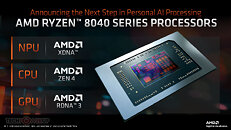
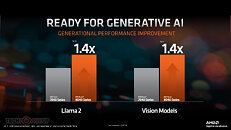
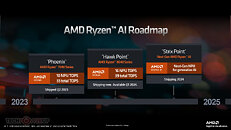
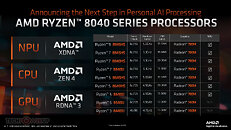
At the hardware level, except the faster XDNA NPU, "Hawk Point" is essentially a refresh of "Phoenix," with generational increases in CPU clock speeds, and power management optimizations to ensure that the faster NPU fits within TDP envelopes typical of U-segment and P-segment mobile processors. The chip is built on the 4 nm EUV foundry node at TSMC. The monolithic silicon packs an 8-core/16-thread CPU based on the "Zen 4" microarchitecture. Each core comes with 1 MB of dedicated L2 cache, and the eight cores share a 16 MB L3 cache. The iGPU is carried over untouched from "Phoenix," including clock speeds, and retains iGPU model numbers from the previous generation. Based on the RDNA 3 graphics architecture, it packs 12 compute units worth 768 stream processors, 24 AI accelerators, and 12 ray accelerators. The iGPU meets DirectX 12 Ultimate API feature requirements.
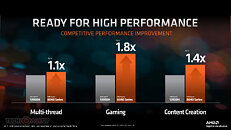

The series is debuting with 9 processor models, 7 of which come with the faster 16 TOPS Ryzen AI NPU, but all of which come with minor CPU clock speed bumps over their predecessors from the Ryzen 7040 series. The series is led by the Ryzen 9 8945HS, with its 8-core/16-thread CPU boosting up to 5.20 GHz, followed closely by the Ryzen 7 8845HS that runs the same 8-core/16-thread CPU at 5.10 GHz max boost. The 8945HS and 8845HS come with configurable TDP ranging between 35 W and 54 W. The Ryzen 7 8840U comes with the same 5.10 GHz maximum boost frequency for the CPU, but with a tighter cTDP of 20 W to 30 W, since it's designed for the ultraportable segment. The 8945HS flagship and all Ryzen 7 SKUs come with a maxed out iGPU dubbed Radeon 780M, which has all 12 CU enabled.
The Ryzen 5 8645HS leads the Ryzen 5 series for this generation. All Ryzen 5 chips are configured with a 6-core/12-thread CPU that has 1 MB L2 cache per core, and an untouched 16 MB L3 cache. The chips also come with a slower iGPU branded Radeon 760M, which has 8 out of 12 CU enabled, worth 512 stream processors, 16 AI accelerators, and 8 ray accelerators. The Ryzen 5 8645HS is configured with a 5.00 GHz max boost frequency for the CPU, while the Ryzen 5 8640HS comes with a slightly slower 4.90 GHz max boost frequency. The 8645HS is designed to play with a cTDP range of 35 W to 54 W, while the 8640HS does 20 W to 30 W cTDP. The Ryzen 5 8640U is designed for ultraportables, with the same 4.90 GHz maximum boost frequency as the 8640HS, but a tighter 15 W to 30 W cTDP range.
At the bottom of the pile are the Ryzen 5 8540U and Ryzen 3 8440U. Both these chips lack the Ryzen AI NPU, and come with a highly cut down iGPU dubbed Radeon 740M, which is configured with just 6 CU (384 stream processors, 12 AI accelerators, 6 ray accelerators); and a cTDP range of 15 W to 30 W. The 8540U comes with a 6-core/12-thread CPU that boosts up to 4.90 GHz, while the 8440U has a 4-core/8-thread CPU that boosts up to 4.70 GHz.
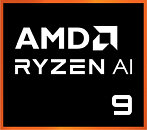
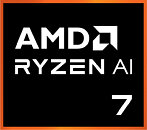
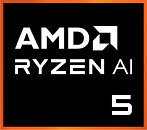
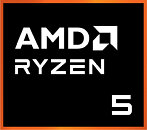
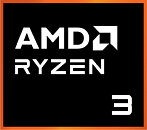
AMD is coming up with a newer case badge design for the Ryzen 8040 series. The SKUs that come with the NPU are branded "Ryzen AI" on the case badge; while those without the NPU lack this "AI" bit.
With the Ryzen 8040 series "Hawk Point" processors, AMD is also introducing the Ryzen AI Software platform in earnest, so software developers can build and optimize their AI accelerated applications and software features to take advantage of the Ryzen AI hardware on the Ryzen 8040 and 7040 series processors that feature the XDNA NPU. The Ryzen AI accelerator supports AI models in industry-standard formats such as PyTorch, TensorFLow, and ONNX.
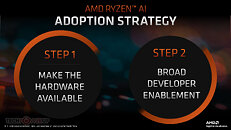

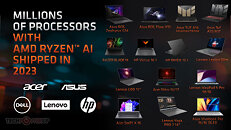
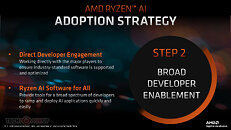
With this launch, AMD is attracting AI software developers with the AMD Pervasive AI Contest. It targets three classes of AI developers, Robotics AI (application such as computer vision and warehouse automation, with as many as 200 Kria KR260 Robotics Starter Kits up for grabs; the hotly contested Generative AI developers, with as many as 300 AMD Radeon Instinct PCIe compute accelerators or cloud instances up for grabs; and PC AI for client PC applications that utilize AI in everyday usecases. For this, AMD is giving away 200 Minisforum desktops powered by 7040 series processors.
The slide deck follows.




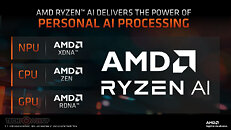

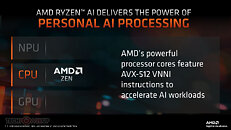
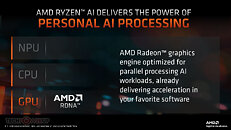






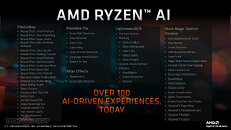

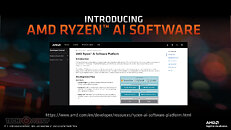
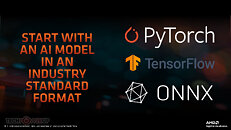
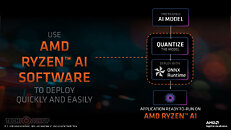
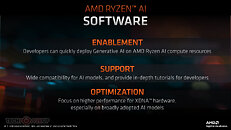






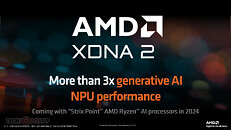


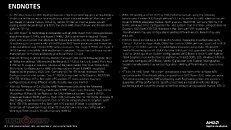
View at TechPowerUp Main Site
The Ryzen 8040 "Hawk Point" processor is almost identical in design and features to the Ryzen 7040 "Phoenix," except for a faster Ryzen AI NPU. While this is based on the same first-generation XDNA architecture, its NPU performance has been increased to 16 TOPS, compared to 10 TOPS of the NPU on the "Phoenix" silicon. AMD is taking a whole-of-silicon approach to AI acceleration, which includes not just the NPU, but also the "Zen 4" CPU cores that support the AVX-512 VNNI instruction set that's relevant to AI; and the iGPU based on the RDNA 3 graphics architecture, with each of its compute unit featuring two AI accelerators, components that make the SIMD cores crunch matrix math. The whole-of-silicon performance figures for "Phoenix" is 33 TOPS; while "Hawk Point" boasts of 39 TOPS. In benchmarks by AMD, "Hawk Point" is shown delivering a 40% improvement in vision models, and Llama 2, over the Ryzen 7040 "Phoenix" series.




At the hardware level, except the faster XDNA NPU, "Hawk Point" is essentially a refresh of "Phoenix," with generational increases in CPU clock speeds, and power management optimizations to ensure that the faster NPU fits within TDP envelopes typical of U-segment and P-segment mobile processors. The chip is built on the 4 nm EUV foundry node at TSMC. The monolithic silicon packs an 8-core/16-thread CPU based on the "Zen 4" microarchitecture. Each core comes with 1 MB of dedicated L2 cache, and the eight cores share a 16 MB L3 cache. The iGPU is carried over untouched from "Phoenix," including clock speeds, and retains iGPU model numbers from the previous generation. Based on the RDNA 3 graphics architecture, it packs 12 compute units worth 768 stream processors, 24 AI accelerators, and 12 ray accelerators. The iGPU meets DirectX 12 Ultimate API feature requirements.


The series is debuting with 9 processor models, 7 of which come with the faster 16 TOPS Ryzen AI NPU, but all of which come with minor CPU clock speed bumps over their predecessors from the Ryzen 7040 series. The series is led by the Ryzen 9 8945HS, with its 8-core/16-thread CPU boosting up to 5.20 GHz, followed closely by the Ryzen 7 8845HS that runs the same 8-core/16-thread CPU at 5.10 GHz max boost. The 8945HS and 8845HS come with configurable TDP ranging between 35 W and 54 W. The Ryzen 7 8840U comes with the same 5.10 GHz maximum boost frequency for the CPU, but with a tighter cTDP of 20 W to 30 W, since it's designed for the ultraportable segment. The 8945HS flagship and all Ryzen 7 SKUs come with a maxed out iGPU dubbed Radeon 780M, which has all 12 CU enabled.
The Ryzen 5 8645HS leads the Ryzen 5 series for this generation. All Ryzen 5 chips are configured with a 6-core/12-thread CPU that has 1 MB L2 cache per core, and an untouched 16 MB L3 cache. The chips also come with a slower iGPU branded Radeon 760M, which has 8 out of 12 CU enabled, worth 512 stream processors, 16 AI accelerators, and 8 ray accelerators. The Ryzen 5 8645HS is configured with a 5.00 GHz max boost frequency for the CPU, while the Ryzen 5 8640HS comes with a slightly slower 4.90 GHz max boost frequency. The 8645HS is designed to play with a cTDP range of 35 W to 54 W, while the 8640HS does 20 W to 30 W cTDP. The Ryzen 5 8640U is designed for ultraportables, with the same 4.90 GHz maximum boost frequency as the 8640HS, but a tighter 15 W to 30 W cTDP range.
At the bottom of the pile are the Ryzen 5 8540U and Ryzen 3 8440U. Both these chips lack the Ryzen AI NPU, and come with a highly cut down iGPU dubbed Radeon 740M, which is configured with just 6 CU (384 stream processors, 12 AI accelerators, 6 ray accelerators); and a cTDP range of 15 W to 30 W. The 8540U comes with a 6-core/12-thread CPU that boosts up to 4.90 GHz, while the 8440U has a 4-core/8-thread CPU that boosts up to 4.70 GHz.





AMD is coming up with a newer case badge design for the Ryzen 8040 series. The SKUs that come with the NPU are branded "Ryzen AI" on the case badge; while those without the NPU lack this "AI" bit.
With the Ryzen 8040 series "Hawk Point" processors, AMD is also introducing the Ryzen AI Software platform in earnest, so software developers can build and optimize their AI accelerated applications and software features to take advantage of the Ryzen AI hardware on the Ryzen 8040 and 7040 series processors that feature the XDNA NPU. The Ryzen AI accelerator supports AI models in industry-standard formats such as PyTorch, TensorFLow, and ONNX.




With this launch, AMD is attracting AI software developers with the AMD Pervasive AI Contest. It targets three classes of AI developers, Robotics AI (application such as computer vision and warehouse automation, with as many as 200 Kria KR260 Robotics Starter Kits up for grabs; the hotly contested Generative AI developers, with as many as 300 AMD Radeon Instinct PCIe compute accelerators or cloud instances up for grabs; and PC AI for client PC applications that utilize AI in everyday usecases. For this, AMD is giving away 200 Minisforum desktops powered by 7040 series processors.
The slide deck follows.






























View at TechPowerUp Main Site








